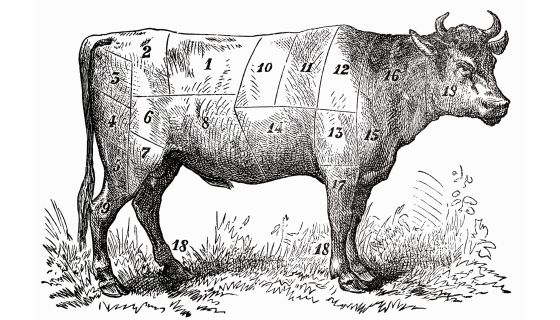Nick frequently teases me for making my choices from a restaurant menu based on what appears on the right-hand side: the vegetables and other accompaniments rather than the main ingredient on the left, more often than not meat.
It’s true that in theory flesh usually interests me much less than what else is on the plate. At large, catered meals my heart rather sinks when I see the standard choice of a lump of meat, usually not-very-thrilling beef.
Knowing that several pages of today’s FT Weekend magazine were to be devoted to meat, however, I decided to research the question of which wines go best with it. I have to confess to a fairly cavalier attitude to food-and-wine matching in general. I find that in practice you can drink more or less anything with any food. If by any chance you encounter a clashing mismatch, a palate rinse with water (which I try always to drink alongside wine) or a mouthful of something as bland as bread can neutralise it.
I suspect that with experience we build up a sort of computer in our brain that subconsciously guides us to make sensible choices. The only place I’d expect an absolutely perfect match is in an extremely fancy restaurant with a fine cellar and a limited menu so the sommelier should be able to provide ideal options at various different price levels.
But our Tamlyn Currin specialises in analysing the interaction between her inventive dishes on the one hand and her cellar and collection of wine samples on the other. See any of these articles. I was especially amazed by the article she wrote to coincide with Valentine’s Day this year in which she argued that the ideal match for roast beef, hot or cold, is pink fizz. On the face of it, this seemed extremely far-fetched. Every guide to food-and-wine matching insists that red wine is the only suitable accompaniment. Indeed the guides usually go into quite a bit of detail suggesting that roast meat is an especially suitable accompaniment to young, tannic red, making up a cocktail of complementary chewiness.
I put these theories to the test with the end of a tri-tip cut of Aberdeen Angus beef reared by Robert Spence on Roberthill Farm in Scotland and bought from a top-quality butcher in London.
First of all I tried a range of reds that I happened to have open, most of them pretty young. Solms-Delta’s Hiervandaan, a juicy blend of Rhône grapes from South Africa, was the youngest, a 2023, so less than a year old. It’s a wine with a story. As chronicled in detail by Tam, neuropsychologist Mark Solms tried, but was forced to abandon, an attempt to transfer ownership of his family’s farm in Franschhoek to those who worked on it.
Six years later, the enterprise has recently been rescued by an American businessman who sympathised with the aim, and the Hiervandaan is one of two wines assembled by a crack South African consultant winemaker from Swartland fruit to signal that Solms-Delta is back in business. This is a red you could happily drink without food and one that I liked a lot but if anything it was a bit too soft and fruity for the beef.
I had also really enjoyed the latest release of Le Difese 2022, a delightfully accessible blend of Cabernet Sauvignon with Sangiovese from the same stable as world-famous Sassicaia on the Tuscan coast. It’s currently more fun than the more serious Guidalberto 2022 bottling, also from Tenuta San Guido. The Sangiovese component added a bit of useful bite to the wine and it was a decent match for the beef but was arguably a little too light.
I then tried a couple of very different Australian reds from my tasting table. Swinney, Farvie Grenache 2022 from the country’s south-west corner was much more tannic than most other wines made from Grenache/Garnacha – so much so that it almost tasted bitter. It may be delicious in future but it was if anything too chewy for the beef. The best match among the reds was Henschke’s concentrated, slightly medicinal but extremely friendly – not too tannic – Keyneton Euphonium Shiraz blend 2019. (See this 2020 wine of the week.)
But I realised that I should also try a classic red bordeaux of the sort so often recommended with beef, so got a bottle of Ch Pichon Baron’s very successful 2012 out of the cellar, a wine that’s already drinking well but still has some tannin. But in fact trying the beef with both this wine and a St-Émilion, Château La Fleur Morange’s Mathilde from the chewy 2008 vintage seemed to emphasise the wines’ tannins slightly uncomfortably.
I then opened the sparkling rosé I had in the fridge, another Australian by complete coincidence, Jansz 2017 from Tasmania based on this sparkling-wine specialist’s best block of Pinot Noir and bottle-aged for ‘904 days’, according to the label. To be honest I didn’t have great hopes, but not only was the wine attractively balanced and interesting, it really did go beautifully with the beef. I think it was the intensity of the combination of fruit and fizz in the wine that was forceful enough to counterbalance the chewiness of the beef. Or, to quote the much more lyrical Tamlyn (honoured recently by Pseuds’ Corner in Private Eye), ‘The Maillard-rich, deep-timbred, uber-umami sweet savouriness and dense-velvet texture of the beef collides with the high-current, crystalline precision, fruit-saturated vibrating tension of the wine and the effect is like a tiny lightning bolt in the mouth.’ I’ll second that.
She’s really on to something here. I also tried the beef with the latest vintage, 2015, of Veuve Clicquot’s top-of-the-range La Grande Dame Rosé – a much darker pink, incidentally, as seems to be the fashion in Champagne now. This combination also worked beautifully, as, I should imagine, would the Pol Roger 2018 Rosé I recently rather lost my heart to.
Another of Tam’s tips is that a squeeze of lemon juice on a steak generally makes it a much better match with a white wine. She writes, ‘another good if unusual meat pairing is Madeira – I’ve had Sercial with roast beef and it’s lovely.
‘But as with all these things, it really comes down to how you’re cooking it. A bit like Hungarian goulash, with all its red spices and red flavours, is much better with white than red. Tomato-strong base notes need lots of acid in the wine (Sangiovese, maybe, or a white). And barbecued ribs with all their sticky sweetness and smokiness are far better with a juicy, alcoholic, even slightly candied-fruit red. Meat with strong gamey flavours (goat, venison, hen, game birds) is actually pretty good with natural wines! Or wines that are a little funky/bretty in style (Musar et al). We have a young gamekeeper friend who brings us pheasants and ducks in shooting season (the kitchen is a mess of feathers) and my favourite wine to drink with whatever we make with them is red Lambrusco, dry or ever so slightly sweet. We’ve made a rustic pâté with duck and pheasant before, it was actually best with a sweeter Lambrusco.’ Coming soon, her unexpected recommended wine with lamb.
But Tam is not the only food and wine expert on our team. Managing editor Tara Q Thomas was a professional chef before turning to wine writing and agrees with Tam on initial principles. ‘From a cook’s perspective, the question is not so much what sort of meat you’re having, but how is it prepared. There’s a world of difference between a steak salad and grilled, dry-aged ribeye or veal scallopini with lemon and capers and those sauced with tomato and mushrooms. Think about the weight of the dish, and match lighter, brighter preparations to lighter whites, rosés or red wines; earthier, darker-toned, weightier dishes will need a darker, richer wine to stand up to the heartier flavours.
‘Mood counts for a lot, too: a big, juicy burger in the middle of winter feels extra-warming with a dark, rich, peppery Rhône red or Zinfandel, but on a hot summer’s day that same burger is going to taste better with something you can put a chill on – a light red or rosé.
‘But, as any restaurateur will tell you, what counts the most is drinking what you like. I knew a restaurateur who drank Condrieu with everything from salad to steak. It was his favourite wine, and it made him happy.’
Tara’s most memorable meat and wine combination, like Tam’s sparkling rosé suggestion, flies in the face of convention.
‘Likely the best wine-and-meat pairing I’ve ever had was at a small restaurant outside Athens, where a platter piled high with little grilled lamb chops came with a bottle of white wine – an Assyrtiko from Santorini. The chops were smoky, juicy, rosemary-scented and ringed with fat; the wine was mouth-wateringly saline and high in acidity, cutting right through that fat. A red would have worked but it would not have been so energising, nor so surprising. It showed that white wines can work spectacularly with meat if they are savoury and firmly structured, like Santorini whites tend to be. Furmint and Ribolla Gialla are another two grapes whose wines are also easy to pair with meat, and skin-contact wines are a shoe-in, as they are essentially white wines with the structure of a red, with tannins to bind to those meat proteins.’
And then there is Julia's revelation of how well amontillado goes with steak.
If you care about what happens in your mouth, the lesson from all this is probably to experiment wildly. And certainly abandon that old ‘red wine with meat, white wine with fish’ thing.
Wine recommendations
Including some current favourite pink fizzes not mentioned above.
Le Difese 2022 IGT Toscana 13.5%
£26.10 Callmewine UK, £29.52 XtraWine UK, £30.20 Noble Grape
Keyneton Euphonium 2019 Barossa 14.5%
£40ish The Wine Reserve, Cambridge Wine Merchants when it arrives next month
Château Pichon Baron 2012 Pauillac 13%
£114 Bordeaux Vintners, £130 Nemo Wine Cellars
Jansz, Rosé 2017 Tasmania
£26 London End Wines, £26.05 VINUM, £27 Australian Wines Online, £30.50 Lecker Wines
Wyfold, Rosé 2018 England 12%
£38 Laithwaites, Avery’s
Digby, Rosé 2018 England 12%
£50 Digby Fine English
Pol Roger Brut Rosé 2018 Champagne 12.5%
£94.95 Champagne One, £96 Hedonism and others
Veuve Clicquot, La Grande Dame Rosé 2015 Champagne 12.5%
£193.20 Brunswick Fine Wines, £240 Millésima UK
Argyros, Assyrtiko 2022 Santorini 14%
£27.21 Lay & Wheeler
Image from Image Professionals GmbH via Getty Images.
Access to over 250,000 tasting notes, with scores and suggested drinking dates, including reviews of hundreds of wines from these producers, is included in membership of JancisRobinson.com. For international stockists, see Wine-Searcher.com.















